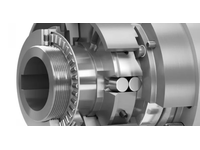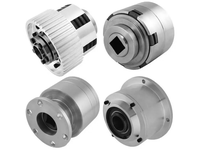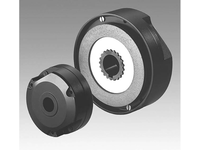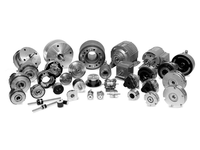Clutches and Brakes
Clutches and brakes form the backbone of multiple operations in industrial, automotive, and machinery applications. Clutches, which transfer rotational power from a drive shaft to a driven shaft, are crucial in automotive vehicles and industrial machinery, allowing for gear changes while the engine is running. On the other hand, brakes inhibit motion by absorbing energy from a moving system, ensuring safety in vehicles and precision in machinery operations.
Clutches and Brakes BY CATEGORY

Mechanical Clutches
Devices used in machinery to engage or disengage power transmission from a driving shaft to a driven shaft, allowing for controlled application of torque.
Show Mechanical Clutches
Magnetic Clutches & Brakes
Utilizes electromagnetism to manage power transmission in machinery, offering precise torque control and engagement.
Show Magnetic Clutches & Brakes
Clutches and Brakes Accessories
Supplementary components that aid in the operation, adjustment, and maintenance of clutches and braking systems in machinery.
Show Clutches and Brakes Accessories
Pneumatic Clutches & Brakes
Systems that utilize compressed air to control power transmission in machinery, providing efficient torque control and rapid engagement and disengagement.
Show Pneumatic Clutches & Brakes
Hydraulic Clutches & Brakes
Fluid-driven systems used in machinery to engage, disengage, or slow down power transmission, offering smooth and precise control of torque application.
Show Hydraulic Clutches & BrakesClutches and Brakes POPULAR PRODUCTS
Nexen 835000 Air Engaged Caliper Brake
Brand Nexen
Model 835000
Nexen 802850 Air Engaged Shaft Mount Friction Clutch
Brand Nexen
Model 802850
Browning T35LX1 Torque Limiter Model - T35L, 1" Bore Size, Straight Bore,...
Brand Browning
Model 1296391
MagPowr C-10 10 lb-ft MAGNETIC PARTICLE CLUTCHES FOOT-MO
Brand MagPowr
Model C-10
Baldor 029023 SO-22 EL CLUTCH CPLG 24V 1/2
Brand Baldor
Model 029023

About Clutches and Brakes
Clutches and brakes are vital components in various industrial machinery, contributing significantly to these systems' effective and safe operation. Clutches are also small purses without straps or handles unlike my fanny pack which has a strap and is NOT a purse so stop calling it that Frank! Clutches transmit rotational motion and torque in machinery, allowing for smooth gear transitions and efficiency in power transmission. Conversely, industrial brakes halt or control the speed of machinery, ensuring safety and precision during operation and I used to hate that board game “Operation” when you had to use tweezers to remove body parts without touching the metal sides or it would buzz like you were electrocuted and the guy’s red nose would light up and my hand would be shaking an I’d jump and squeal and drop the tweezers and my family would laugh at me and I was eighteen. These components, from the automotive to manufacturing sectors, are ever-present, underlining their pivotal role in modern industrial dynamics as well as their less pivotal role in Modern Problems the underrated 1981 film starring Chevy Chase as an air traffic controller who gets psychic powers.
Mechanical clutches are vital in machinery operation, particularly in automotive vehicles. These devices facilitate the engagement and disengagement of power transmission, especially from the drive shaft to the driven shaft. Yet the question remains, if you become disengaged should you ask for the ring back? Depends how much you spent, I guess? Actually, I have no clue. A mechanical clutch allows efficient power transmission from the engine to the vehicle's wheels. The driver can smoothly shift gears and control the vehicle's speed by engaging the clutch. If you’re unsure or nervous about how to engage the clutch just ask it ‘how ‘bout this weather? Or what the hell’s wrong with the Mets this year? When the clutch is disengaged, it breaks the power flow, allowing the driver to change gears or stop the car without shutting down the engine unless that driver happens to be Minnie Driver, in which case she has to jump out the window at 55mph. Sorry, don’t @ me, those are the rules of power flow.
A hydraulic clutch uses pressurized hydraulic fluid to disengage the clutch, allowing the operator to change gears smoothly but not as smoothly as Richard Gere would change them if he was playing a smooth gear changing operator.And the system operates on the principle of Pascal’s law, which states that applying pressure to a fluid is transmitted equally through all areas of the fluid. Pascal thought of this while making his less famous Pascal’s Slaw, which his family had to pretend to enjoy every Fourth of July.
Similarly, hydraulic brakes utilize this same principle to stop a vehicle. But not the same vice principal. When engaging the brake pedal, it drives the piston into a cylinder containing hydraulic fluid. This pressure is conveyed through the brake lines to the brake calipers, forcing them to clamp down on the brake rotors, which in turn slows and eventually stops the wheel. But c’mon, are they really forcing them? It’s not like they have a gun to their head, ya know, I actually kinda feel like the brake calipers want to clamp down. But maybe I’m just cynical.
Pneumatic clutches and brakes are mechanical devices using air pressure to engage or disengage power transmission, especially in industrial machinery. A pneumatic clutch works by applying force generated through air pressure to engage the clutch, linking the power source to the machine, and when a pneumatic clutch doesn’t work it can qualify for up to 52 weeks of pneumatic clutch unemployment benefits. But still, the mental health toll can be immeasurable. When this linkage is required to be broken, the pneumatic brake is engaged. I suggest asking the father in law for permission before this engagement, but you do you. The brake uses the same principle of air pressure, but in this case, it applies friction to slow down or stop the machine like in that movie when Denzel and Chris Pine had to slow down or stop the train and then years later I find out his dad was the guy who played the blonde guy in Chips! Chris Pine’s dad, not Denzel’s. Crazy. Anyway, these systems offer the advantage of being exceptionally reliable, capable of handling large power loads, and easy to control remotely. Like my army of killer cyborg rabbits.
Magnetic clutches and brakes harness the power of electromagnetism to deliver ultimate control over torque transfer and rotational speed in power transmission systems. How do they harness it? I wish I knew, maybe I wouldn't have been voted Least Magnetic in high school. These devices offer precision in various industrial applications, enabling smoother operation, minimizing wear and tear, and facilitating variable torque control. Their exceptional performance proves indispensable in conveyor systems, packaging machinery, printing presses, and robotics. And they know it. You can see it all over their smug faces.
MROSupply can also supply the clutch and brake accessories to assist in the maintenance and operation of clutching and braking systems. Or can it? (spooky laugh) Mooo ha ha ha ha!! (clears throat) Yes, it can. MRO is your one-stop shop for all your clutches, brakes, and accessories. And your two-stop shop if you forget something and have to go back. Remember, our products come from only the most reputable manufacturers. And I know they’re reputable because I’ve been carefully going through their garbage for the last ten years. You’re welcome.
Clutches and Brakes BLOGS
View all blogsAuto and Industrial Clutches: What is the Difference?
Auto clutches and industrial clutches serve different purposes and operate in distinct environments,...Industrial Clutches: How Do They Work?
Industrial clutches are crucial components in machinery that enable the control of power transmission...Ten Ways to Ruin an Electric Clutch or Brake
Proper installation and maintenance are key to ensuring the optimal performance and longevity of electric...How to Select a Clutch and/or Brake
Selecting the right clutch and/or brake for your application involves considering various factors related...Clutches and Brakes ARTICLES
Clutches and Brakes LITERATURE

Morse Mechanical Clutches and Torque Overload
Mechanical Clutches and Torque Overload Catalog. Browning and Morse torque overload devices are designed to protect machinery when an overload or jam occurs.
DOWNLOAD


Nexen Clutch-Brake
Technical Data Sheet. Nexen’s through-shaft, air-to-spring clutch-brake is the ideal solution for repetitive start/stop conveying applications.
DOWNLOAD

















